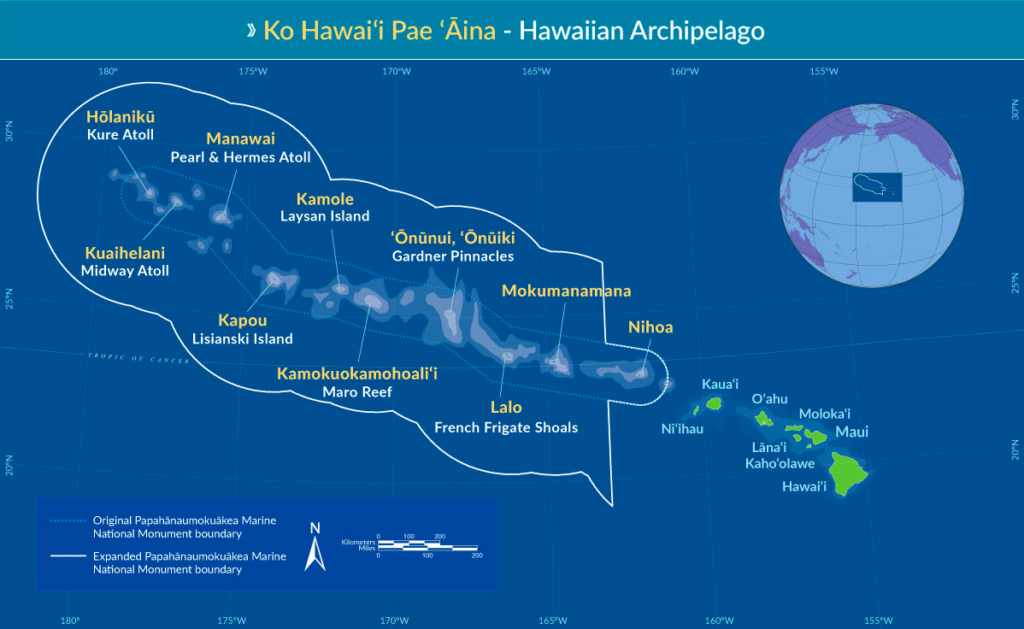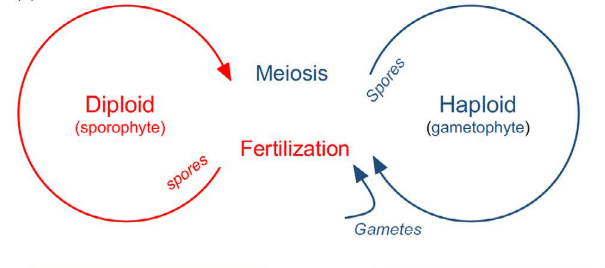
About the author:
Taylor Williams (she/her) is a Ph.D. student in Dr. Stacy Krueger-Hadfield’s Evolutionary Ecology lab at The University of Alabama at Birmingham. This blog post was written as a part of Dr. Krueger-Hadfield’s Fall 2022 Ecological Genetics course. Taylor received her B.S. in Marine Biology from the University of Hawai’i at Mānoa then went on to receive an M.S. from the College of Charleston while working under Dr. Heather Spalding. Her research combines natural history observations with population genetics to investigate the reproductive system and evolutionary trajectory of an invasively behaving red seaweed in the Papahānaumokuākea Marine National Monument.
Midway Atoll occupies just over 6 km2 of the Pacific Ocean and lies within the Hawaiian Archipelago (Figure 1). Originally famed for the 1942 Battle of Midway which was a turning point in the Pacific’s role in World War II, Midway is now well known for being a National Wildlife Refuge. As a refuge, Midway is home to the world’s largest albatross colony, one of the last Laysan duck populations, a diverse barrier coral reef spanning five miles wide, and nesting grounds for several federally protected marine species including green sea turtles and the endemic Hawaiian Monk Seal. Although the historic military Battle of Midway ended over 80 years ago, Midway Atoll is still facing ecological battles daily.

The National Wildlife Refuge faces rising sea levels, coral bleaching, marine debris, wildlife diseases, and invasive species (NOAA Office of National Marine Sanctuaries 2020). Since the United States Naval occupation of Midway, the islands and surrounding waters of this atoll have been no strangers to invasive species. Terrestrial invaders range from plants to rodents and marine invaders include invertebrates, fishes, and recently, invasive seaweeds. The most recent reports of an invasively acting species at Midway are those of Chondria tumulosa – a mat forming red seaweed that has been found overgrowing the reef for hundreds of km2, decimating the coral reef below and reducing native species diversity and abundance (Sherwood et al. 2020; Figure 2). Although you would think we know a lot about an alga that is smothering corals reefs in a Marine National Monument, we actually don’t. In fact, aside from its taxonomic group, we know next to nothing. It was Chondria tumulosa, that led me and the other three members of our small scientific team to make the 1,300-mile journey from O’ahu to Midway Atoll.
One of our central goals for our time at Midway was to collect hundreds of population-level samples that would later be used to study the reproductive system of Chondria tumulosa. The reproductive system partitions genetic diversity within and between populations and is thus responsible for the ecological and evolutionary trajectory of a population, and of a species (Hamrick and Godt 1996, Barrett 2011). This makes understanding how a species reproduces one of the most fundamental things needed to produce effective management strategies, and yet we are missing this information for C. tumulosa. What we do know is that like all other red macroalgae, C. tumulosa has a life cycle that consists of both long-lived haploid gametophytes and long-lived diploid sporophytes (Figure 3). The presence of two long, free-living life cycle stages has unique eco-evolutionary consequences (Krueger-Hadfield 2020). For example, asexual reproduction in haploid-diploid taxa often leads to the dominance of one life-cycle stage and loss of the other (Krueger-Hadfield et al. 2016). Depending on what life cycle stage is lost, recovery of sexual reproduction can be difficult (Krueger-Hadfield and Hoban 2016). Reproductive system variability directly impacts invasion success and establishment (Baker 1955) making quantification of the reproductive system critical to management.

Our well-rounded team of four field biologists, armed to do the work of ten projects in just over two weeks, set out for Midway in July 2022. After becoming accustomed to the ship-based field work notorious throughout the Hawaiian Archipelago (and as I described in an AGA blog post I wrote last year), the private 3-hour night flight to Midway felt like nothing shy of luxury. The reflection of the moonlight off the fringing reef was a good indicator that we had arrived, and the potent smell of the largest albatross nesting ground, was an even better indicator of our arrival. Once settled into our former military bunkhouse rooms for the night, it was time to start preparing for the long days ahead of us.
Each day began with a bike ride (Midway’s primary form of transportation) to the original military base’s jail house that we turned into our own private lab space. It was there in that makeshift lab space where our days began early and ended late. This space was used to prep hundreds of sampling bags, collection tools, dive gear, and coolers long before the sun came out to play. We poured over microscopes on the hunt for reproductive structures and labored for hours ensuring each one of our hundreds of samples were preserved just right for genotyping.

In the evenings, we took to the La-Z-Boy sofas and debated maps, weather reports, and sampling sites in fruitless attempts at strategizing a plan of attack for the following day, all while knowing nothing would go as planned. We even took to naming all of our porch albatross (an activity recommended against during fledging season)… and unfortunately, it was where all four of us battled a bout of food poisoning – of which would later be referred to as ‘the Midway Montezumies’. It was this once jailhouse that served as home: the space that we melded into one unit, all working towards understanding the ecological success of Chondria tumulosa. Now that we have said farewell to our makeshift lab space and made the long journey home, with hundreds of samples in tow, we can begin the next battle: lab work – complete with DNA extractions, genotyping, and estimating a suite of population genetic indices that will help shed light on C. tumulosa’s reproductive system.
Although the Battle at Midway came and went in 1942, Midway is certainly still facing battles of its own. The invasive nature of this alga makes management of this species critical, particularly regarding reduction of further spread to other areas throughout the Hawaiian Archipelago. Our hope is that this work equips managers for the new ecological battle that Midway faces.
References:
Baker, H. 1955. Self-compatibility and establishment after “long-distance” dispersal. Evolution1. 9:347–9.
Barrett, S.C.H. 2011. Why reproductive systems matter for the invasion biology of plants. In Richardson, D. M. [Ed.] Fifty Years of Invasion Ecology: The Legacy of Charles Elton. Blackwell Publishing Ltd, pp. 195–210.
Hamrick, J. & Godt, M. 1996. Effects of life history traits on genetic diversity in plant species. Philos. Trans. Biol. Sci. 351:1291–8.
Krueger-Hadfield, S.A. 2020. What’s ploidy got to do with it? Understanding the evolutionary ecology of macroalgal invasions necessitates incorporating life cycle complexity. Evol. Appl. 13:486–99.
Krueger-Hadfield, S.A. & Hoban, S.M. 2016. The importance of effective sampling for exploring the population dynamics of haploid-diploid seaweeds. J. Phycol. 52:1–9.
Krueger-Hadfield, S.A., Kollars, N.M., Byers, J.E., Greig, T.W., Hammann, M., Murray, D.C., Murren, C.J. et al. 2016. Invasion of novel habitats uncouples haplo-diplontic life cycles. Mol. Ecol. 25:3801–16.
NOAA Office of National Marine Sanctuaries 2020. 2020 State of Papahānaumokuākea Marine National Monument: Status and Trends 2008-2019. 232.
Sherwood, A.R., Huisman, J.M., Paiano, M.O., Williams, T.M., Kosaki, R.K., Smith, C.M., Giuseffi, L. et al. 2020. Taxonomic determination of the cryptogenic red alga, Chondria tumulosa sp. nov., (Rhodomelaceae, Rhodophyta) from Papahanaumokuakea Marine National Monument, Hawai’i, USA: A new species displaying invasive characteristics. PLoS One. 15.



